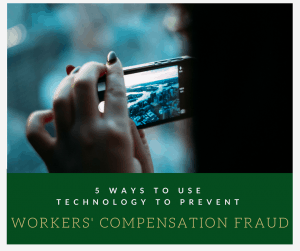
As an employer, you have a vested interest in the well-being of your employees. You mandate safety training and encourage care in the workplace to prevent injuries. If the worst should happen and a workers gets injured on the job, you want them to enjoy a speedy recovery and likely hope to re-employ them as soon as they are able to return to work. But what happens when an employee violates your trust and attempts to defraud you?
Unfortunately, workers’ compensation insurance fraud is rampant in the workplace today. It is common across industries, regardless of education level or income. Preventing fraud, which costs U.S. companies billions of dollars each year, isn’t always easy. Having great technology on your side, however, can make it far easier to prevent fraud and stop it in its tracks when it does occur. Read on for 5 key tips for preventing fraud with today’s tech.
- Install cameras in the workplace where permitted.
Depending on the sort of business you run, you may be able to install surveillance cameras in key locations. Not only can this be great for workplace productivity, it can mean the difference between the success and failure of certain fraud cases. Workplace cameras can catch everything from major stove accidents in the kitchen of restaurants to slip-and-fall cases on the sidewalk outside your daycare. Having video on hand to prove what really happened and who was at fault is critical.
- Employ an investigator to check social media.
If an employee is out of work and collecting workers’ compensation payments, it’s a good idea to have your investigative company check up on the claimant via social media to ensure nothing untoward is occurring. Believe it or not, some claimants plaster their social media profiles with videos of themselves skateboarding, skiing, horseback riding, dancing, or doing other activities their injuries shouldn’t allow. This sort of evidence should be saved and filed for a potential fraud hearing.
- Ask your investigative company about remote aerial cameras.
In some jurisdictions and certain instances, the use of remote aerial cameras to gain footage of claimant activity might be allowed. Ask your investigative company what is permitted in your area. Reasonable expectation of privacy laws and FAA regulations are increasingly limiting when it comes to use of this technology, however.
- Ask your private investigator about remote cameras.
Remote surveillance cameras have the unique benefit of being highly portable and extremely covert. Often less than one square inch in size, cameras can be placed in a variety of locations and almost certainly won’t be detected by a claimant. In this way, remote surveillance cameras can act as an extension of an investigator, offering round-the-clock surveillance in any legally appropriate location. Read more about remote cameras here.
- Ask your investigative company about cell phone pinging or license plate tracking.
Where permitted by law, it is often possible to gain actionable intelligence about a claimant by pinging their cell phone or using technology to track their license plate. This allows investigators to know if the claimant has been active when they allege they cannot leave the house, for instance.
Want to learn more about considerations surrounding the use of remote surveillance cameras? Check out this whitepaper by Alliance Risk Group CEO Mario Pecoraro. It details 7 factors to consider before using remote surveillance in a claims investigation.
Still have questions? Contact Alliance Risk Group today to learn how thorough claims investigations can benefit your company. To submit an assignment, click here to complete our referral form.
